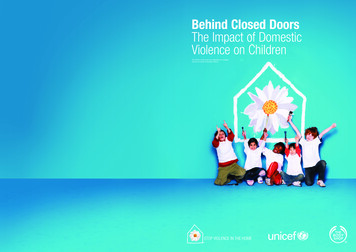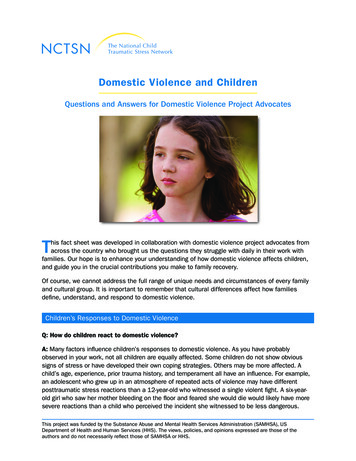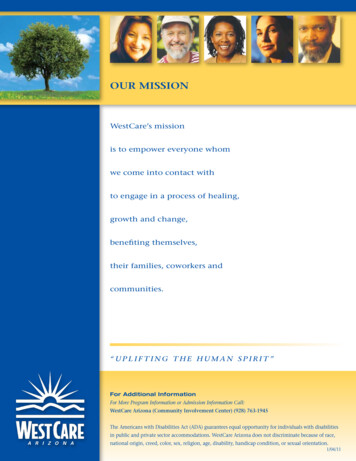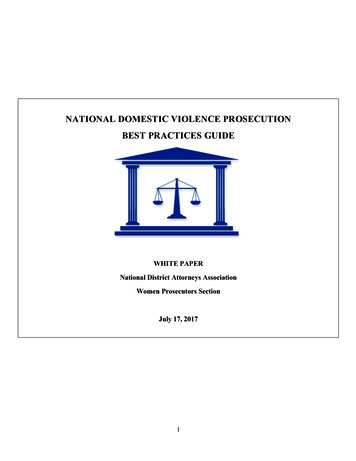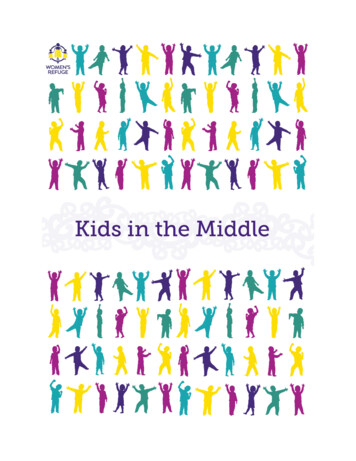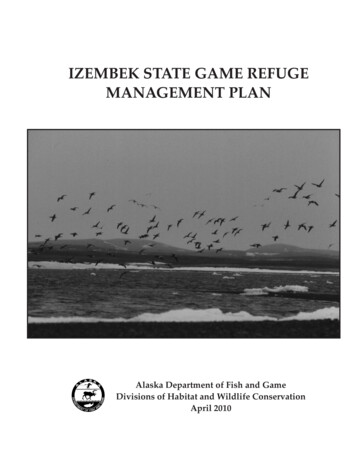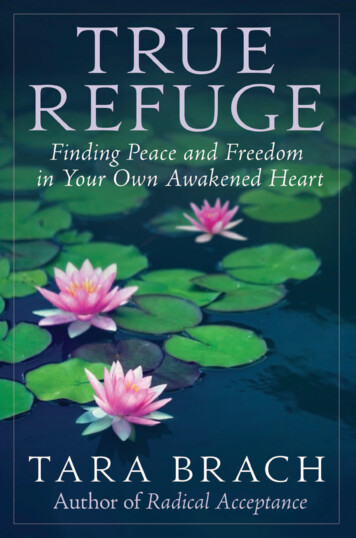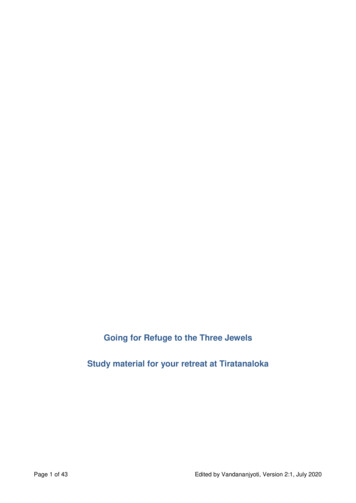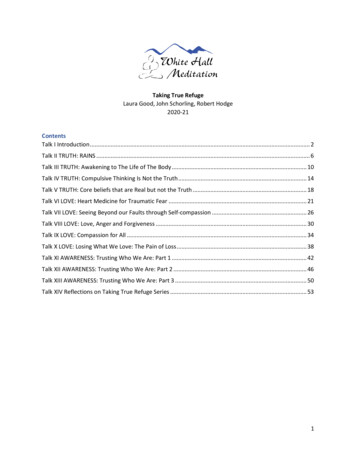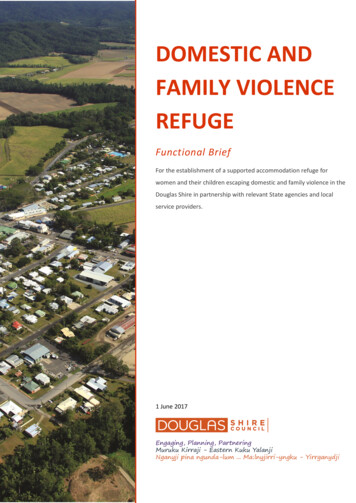
Transcription
DOMESTIC ANDFAMILY VIOLENCEREFUGEFunctional BriefFor the establishment of a supported accommodation refuge forwomen and their children escaping domestic and family violence in theDouglas Shire in partnership with relevant State agencies and localservice providers.1 June 2017
Domestic and Family Violence RefugeFunctional BriefContents1.Executive Summary . 32.Introduction . 43.4.2.1.Purpose of the functional design brief . 42.2.Overview of the project . 4Project Background . 43.1.Domestic and family violence in the Douglas Shire . 43.2.Current service response . 53.3.Vision for the project . 63.4.Project objectives . 6Project Scope and Context . 64.1.Domestic and Family Violence definition . 64.2.Victims of domestic and family violence . 64.2.1.Target Groups . 74.2.2.Groups identified as needing a different model of assistance . 74.3.5.6.7.Methodology . 8Strategic Policy and Direction. 85.1.National context . 85.2.Queensland Government . 8Options for Domestic Violence Refuge and Crisis Accommodation. 96.1.‘Safe at Home’ models. 96.2.Communal Shared Living . 96.3.Cluster Model . 106.4.Dispersed . 116.5.Safe House . 11Recommended Facility Profile for Douglas Shire . 117.1.Client demographics and specific needs in consideration . 127.1.1.Aboriginal and Torres Strait Islander women . 127.1.2.Older women and rural women . 127.1.3.Women with children . 137.1.4.Tourists and travellers . 13#802880.Domestic and Family Violence Refuge Functional Brief.Douglas Shire Council. 1 of 34
7.2.7.2.1.Bed and bed equivalent projections. 137.2.2.Length of stay . 147.3.Secret urban location . 157.3.2.Remote area . 157.3.3.Open suburban location . 15Summary of staffing requirements. 16Key Design Requirements . 168.1.Facility design objectives . 168.2.Operational principles and design . 168.3.Resident environment / unit configurations . 178.3.1.Bedrooms. 198.3.2.Kitchen . 208.3.3.Family Space . 208.3.4.Outside . 218.3.5.Bathroom . 218.3.6.Laundry facilities . 228.4.Staff environment. 228.5.Communal areas and shared space . 228.5.1.Interior . 238.5.2.Outside . 238.6.Amenity . 248.7.Security . 268.8.Equity of access . 278.8.1.People with Disabilities . 278.8.2.Older Women . 278.8.3.Women with complex needs including mental health or substance abuse problems . 278.8.4.Equitable Access . 278.8.5.Culturally appropriate safe space . 288.9.8.10.9.Location . 157.3.1.7.4.8.Activity projections . 13Storage Facilities . 28Future proofing and flexibility . 29Operational Considerations . 299.1.Admissions, Access and Hours of Operation . 299.2.Building maintenance services . 29#802880.Domestic and Family Violence Refuge Functional Brief.Douglas Shire Council. 2 of 34
9.3.Linen/crockery . 299.4.Pets . 2910.Relationships and interdependencies with external agencies . 2911.Conclusion – Next Steps . 3012.References . 3113.Appendices . 32Consultations with Key Douglas Service Providers. 321. Executive SummaryDomestic and family violence is a canker that infects us all: victims, responders, perpetrators andcommunity. Its victims are old, young, rich, poor, black, white, women, children and men. Its effects arefelt long after the violence occurs. Women who experience domestic and family violence face poor overallphysical and psychological health and wellbeing outcomes including increased risk of Post-Traumatic StressDisorder, substance misuse, homelessness and suicide. Children who witness family violence are subject topsychological and behavioural impacts, health and socioeconomic impacts, and the intergenerationaltransmission of violence and re-victimisation. This project was undertaken against a backdrop in which oneAustralian woman is killed every week by her current or former partner, where the number of domesticviolence incidents reported in Queensland is increasing annually, and where high profile and tragicoccurrences are in the media nearly every week.The Douglas Shire has one of the State’s highest rates of reported domestic and family violence coupledwith a high proportion of the population especially vulnerable to barriers restricting access to supportservices. Douglas has a high percentage of Aboriginal and Torres Strait Islander residents. The regionconsists of small, discrete ‘rural and remote’ population centres, has a lack of affordable public transport,affordable housing, specialist domestic violence services and no crisis accommodation. The response forwomen escaping domestic violence is a referral to agencies in Cairns where demand for supportedaccommodation consistently outstrips supply. One half of all victims seeking shelter in Australia are turnedaway because of a lack of available refuge beds, and without access to safe and secure accommodationmany victims of domestic and family violence will return to their abusers.As important as having a roof overhead, is the type of accommodation service provided to victims escapingdomestic and family violence. Perpetrators of family violence control their victims over extended periods,affecting their autonomy, ability to make decisions, self-esteem and identity. A domestic and familyviolence refuge should provide an environment that helps victims develop or regain the life-skills andindependence necessary to break the cycle and move past their traumatic experiences.The Douglas Shire requires a facility to provide crisis and supported accommodation services to women andtheir children escaping domestic and family violence. The current practice of service organisations referringvictims to refuges is Cairns or attempting to temporarily place victims in unsupported accommodation inmotels, is inadequate and ineffectual. This Brief sets out the gaps in current service delivery and identifiesthe model of facility required to best address the absence of domestic and family violence refuge in theregion.#802880.Domestic and Family Violence Refuge Functional Brief.Douglas Shire Council. 3 of 34
2. Introduction“Each and every Queenslander has the right to feel safe, and be safe, especially in their own home.Domestic and family violence is a violation of this basic human right.” Queensland Says: Not Now, Not Ever.Domestic and Family Violence Prevention Strategy 2016 – 2026.2.1. Purpose of the functional design briefThis functional brief sets out the infrastructure requirements and service considerations of a Domestic andFamily Violence Refuge to service the needs of women and their children escaping domestic and familyviolence in the Douglas Shire.The design detail provided in this brief will be used to inform concept planning and facility design. It willalso be used in the development of the project’s business case documents and to advocate for full or partfunding of the project.2.2. Overview of the projectThe following report provides: Evidenced need for a crisis accommodation response to domestic and family violence in the region Alignment with existing government policies and priorities The best practice model for a shelter to suit the needs of this region Design and operational requirements for the facility3. Project BackgroundThe Douglas Shire covers an area of 2,445 km2 from Cairns Regional Council and Ellis Beach in the south toWujal Wujal and the Cook Shire in the north. Douglas Shire has an estimated population of 11,661residents as at 30 June 2015; 70 per cent of whom live in the two population centres of Port Douglas andMossman, with other urban populations in Wonga, Newell and Cooya Beaches. Douglas is a decentralisedregion with communities scattered along the 100 km stretch of coast road and rainforest or tucked intosmall rural townships. Aboriginal and Torres Strait Islander people compose 8.5 per cent of the communitycompared to 3.6 per cent of the overall Queensland population. The Douglas Shire has a slightly olderpopulation than the State in general and a higher proportion of families with young children.The Australian Bureau of Statistics classifies 93.7 per cent of the Douglas population as ‘Outer Regional’ andthe remainder as ‘Remote’ or ‘Very Remote’ according to the Accessibility/Remoteness Index of Australiaclassification. Women in rural and remote areas face greater challenges in reporting violence and seekingsupport including tyranny of distance, isolation, a lack of transport, financial insecurity, fears aboutconfidentiality and a lack of services within the area, especially in affordable housing options. Where thereare no accommodation options, women are more likely to remain trapped in violent situations.3.1. Domestic and family violence in the Douglas ShireThe Douglas Shire has high rates of reported domestic and family violence. In 2013-14 rates of domesticviolence applications per 100,000 persons in the Far North Queensland region were 946, second in theState after Mt Isa, and 190 applications higher than the third region, Capricornia.11Special Taskforce Queensland. 2015. Not Now, Not Ever.#802880.Domestic and Family Violence Refuge Functional Brief.Douglas Shire Council. 4 of 34
Far North Police Data2Rank by highest % perpopulation of DVApplications12 Mossman36 Port DouglasDV ApplicationsPopulationat 2011Census173232052014-152015-16% perpopulation692564283.70 %0.87 %Contravene DFVPOOccurrence Count2014-152015-1649236018This data does not come close to representing the true extent of the problem as much of domestic andfamily violence occurs in private and goes unreported.3.2. Current service responseThere are currently no emergency or crisis accommodation facilities and a lack of affordable housing in theDouglas Shire. The current response for victims escaping domestic and family violence is to refer them to ashelter in Cairns or to arrange a motel in the short-term.Dependence upon refuge space in Cairns is not adequate or appropriate for the needs of women and theirchildren as: Cairns often lacks enough refuge space for their own needsTransporting people to Cairns requires time and resources lacking in DouglasVictims are required (and often reluctant) to leave their support networks, schools, jobsIt’s too far from their supports and community or it’s too hard to get there. As soon as they find out it’sin Cairns, they’re just not interested.3“[T]he practice of placing women and children escaping violence in hotels, motels or caravan parks becausethere are no available refuge beds, verges on system neglect.” 4 Without access to support services orlonger term accommodation, it is very difficult for victims of domestic and family violence to break thecycle of violence.Service provider concern about the lack of facilities caused a group of agencies led by the Port Douglaspolice to instigate a committee, DvEAF (Domestic Violence Emergency Accommodation Fund), to raisedonations to fund emergency motel accommodation for victims of domestic and family violence. Relianceon donations is not a sustainable response to the accommodation needs of women and their childrenescaping domestic and family violence.We recently worked together with Mossman Community Centre to help a woman in her 60s move intoshared accommodation with five other people. All the long-term support we could give her is unfunded:clothing, food, toiletries, referrals to legal advice, volunteers giving her English lessons as English is asecond language, cooking lessons, going to CWA for socialisation and sewing. The NeighbourhoodCentre does unfunded stuff because, how can you not?52Statistics provided by the Department of Communities, Child Safety and Disability ServicesPort Douglas Police4Weeks and Oberin 2004. Women’s Refuges, Shelters, Outreach and Support Service5Port Douglas Neighbourhood Centre3#802880.Domestic and Family Violence Refuge Functional Brief.Douglas Shire Council. 5 of 34
3.3. Vision for the projectTo achieve a facility with the capacity to provide emergency and transitional accommodation for womenand their children escaping domestic and family violence in the Douglas Shire with specialist supportservices and links to the broader service providers in the region, to negate the need for victims of violenceto choose between leaving the region or staying with violence.3.4. Project objectives Demonstrate the need for a domestic and family violence refuge to cater for residents of theDouglas region Identify the most appropriate model of domestic and family violence refuge for the Douglas Shire Detail the design requirements and support service considerations necessary to deliver such aresource4. Project Scope and ContextThe purview of this project was to: Examine theo Extent and specifics of domestic and family violence, and organisational response tosupport victims, in the Douglas Shireo Potential of various models of domestic violence refuge to address the crisisaccommodation needs of the Douglas ShireDevelop a Briefo Describing the infrastructure design requirements of a best practice, fit for purpose, facilityo Detailing the evidence of need and justification for described model of refuge to beemployed in the development of a business case and advocacy for funding contributionsfor the implementation of the project4.1. Domestic and Family Violence definitionDomestic and family violence occurs when one person in an intimate personal, family or informal carerrelationship employs an ongoing pattern of violence or abuse to maintain power and control over the otherperson.Under the Domestic and Family Violence Protection Act 2012 (Qld), intimate personal relationships includemarried and de facto spouses; parents of a child; people who are, or were engaged; and people in couplerelationships, including same-sex couples. Family relationships exist between two people who are relatedby either blood or marriage, including extended or kinship relationships where a person is regarded as arelative. Informal care relationships exist where one person is or was dependent on another person forhelp with essential daily tasks, where care is provided other than on a commercial basis.The Act defines the conduct of domestic violence as including physical, sexual, emotional, psychological,and economic abuse or any other threatening, coercive, or controlling behaviour which causes the victim tofear for their safety or wellbeing, or that of someone else.4.2. Victims of domestic and family violenceAlthough domestic and family violence can occur within any form of relationship and towards any personregardless of personal, cultural or economic standing, individuals belonging to certain groups are morevulnerable than others.#802880.Domestic and Family Violence Refuge Functional Brief.Douglas Shire Council. 6 of 34
Men can be and are victims of violence and coercive control but statistics tells us that the majority ofsexual, physical and emotional abuse is committed by men against women and understanding thegendered nature of domestic and family violence is vital in designing and delivering an effective response.6Aboriginals and Torres Strait Islanders, people from culturally and linguistically diverse (CALD) backgrounds,the elderly, people with a disability, people in rural and remote communities, people who identify aslesbian, gay, bisexual, transgender or intersex (LGBTI), and children “are all at significantly higher risk fromthe incidences and impacts of domestic and family violence.”7 People from these groups may experienceviolence in a different way to others and face additional challenges when attempting to get protection andsupport.Other groups also face extra challenges accessing services: women with substance abuse or mental healthissues, grandparents who parent children of violent partnerships, families with pets and women withseveral, or older male, children.While incorporating best practice elements pertinent to the majority of these populations, this projecttargeted those groups which most frequently come to the attention of local agencies as needing assistanceand most vulnerable to barriers blocking access to services necessary to escape the cycle of domestic andfamily violence.4.2.1. Target Groups Aboriginal and Torres Strait Islander womeno Experience high rates of domestic and family violence and constitute the majority, but byno means all, of victims of domestic and family violence seen by police in MossmanNon-Indigenous womeno Service providers report male victims of domestic violence but the vast majority arewomenFamilies with childreno Most of these women have children with them when seeking assistance, often more thanthreeAll locations in Douglas are considered ‘rural’ or ‘remote’o Presents additional challenges to accessing services4.2.2. Groups identified as needing a different model of assistance 67The majority of reports of domestic violence from the Port Douglas area involve couples holidayingin the town from elsewhereoTemporary, emergency accommodation is generally procured from AccommodationProviders in Port DouglasoFurther assistance is best offered and received in their place of permanent residenceoNot a priority target group of this project as immediate crisis accommodation needs can bemet through the existing response model: process improvements are currently beingexpedited by Port Douglas police and service providersDouglas services reported several unaccompanied minors homeless from escaping family violence2012 Australian Bureau of Statistics Personal Safety Survey. Queensland Government 2016. DFV Prevention Strategy.Special Taskforce Queensland. 2015. Not Now, Not Ever.#802880.Domestic and Family Violence Refuge Functional Brief.Douglas Shire Council. 7 of 34
oIt is acknowledged that unaccompanied minors are a very vulnerable group for whom gapsin services in this region should be further investigated4.3. MethodologyThis brief uses an evidence-based methodology to explore options for a best practice model of refuge tosuit the needs of the Douglas Shire both financially and in outcomes for victims and the broadercommunity. Interviews with Queensland Police Service and representatives of government and nongovernment agencies responding to domestic and family violence in the Douglas ShireInterviews with specialist domestic and family violence service providers involved with domesticviolence refuges and crisis accommodation in Far North QueenslandLiterature search of Australian and international best practice domestic and family violenceaccommodation responseWorkshop with Department of Communities, Child Safety and Disability Support, and Douglasservice providers comparing models of accommodation currently funded by the DepartmentDue to the vulnerable state of domestic and family violence service recipients, it was not possible tointerview past or current residents of refuges and this research relies on input from service providers andprecedent studies.It is not within the scope of this report to consider strategies for the prevention of domestic and familyviolence or strategies for early intervention responses. The report notes that the vast majority of womenaffected by domestic and family violence do not access crisis accommodation but “make their own waythrough the trauma of the violence and the housing system, or stay with friends or relatives.”8See appendix for a list of consultations with key stakeholders.5. Strategic Policy and Direction5.1. National contextImproving the way we respond to domestic and family violence is a prominent theme in our nationaldiscourse with one Australian woman killed every week by her current or former partner and high profilecriminal trials appearing regularly on our nightly news. The National Plan to Reduce Violence against Women and their Children 2010 – 2022 was endorsedby COAG and targets both domestic and family violence and sexual assault. The White Ribbon campaign, Australia’s CEO Challenge, the naming of Rosie Batty as Australian ofthe Year in 2015 all contribute to the momentum for culture change to keep women and theirchildren safe from domestic and family violence.5.2. Queensland GovernmentSince the Queensland Child and Family Reform initiatives developed in response to the Child ProtectionCommission of Inquiry in 2013, Queensland has focussed on improving responses for children and theirfamilies affected by domestic and family violence. 989Tually, Faulkner, Cutler and Slatter 2008. Women, DFV and Homelessness.Queensland Government 2016. DFV Prevention Strategy.#802880.Domestic and Family Violence Refuge Functional Brief.Douglas Shire Council. 8 of 34
Beginning in 2014, nine Regional Child and Family Committees have been established to “monitorand implement domestic and family violence reforms at the local level” The Special Taskforce on Domestic and Family Violence in Queensland released its report ‘Not Now,Not Ever: Putting and End to Domestic and Family Violence in Queensland’ in 2015, with 140recommendations for government ‘Queensland says: Not Now, Not Ever.’ Domestic and Family Violence Prevention Strategy 20162026 aims, among other things, “to recognise the victim’s perspective, prioritise their safety andreduce the onus on them to take action or to leave” 10There have been a range of reforms in Queensland domestic and family violence policies and proceduressince the Bryce Report including an increased localisation of services and investment in regional areasincluding perpetrator programs in Cape York; the Local Support Coordination Initiative and the planned2017-18 roll out of High Risk Teams in Cairns as part of an integrated response.6. Options for Domestic Violence Refuge and Crisis AccommodationDomestic and family violence is the most common cause of homelessness among women and is awidespread and increasing problem. Domestic violence related homelessness is different from other formsof homelessness because many women return to the perpetrator, cycling in and out of homelessness andcrisis accommodation as they try to rebuild their relationship with their partner. Women who escape fromdomestic and family violence may also not have the life-skills to sustain a tenancy in the private marketwithout sustaine
This data does not come close to representing the true extent of the problem as much of domestic and family violence occurs in private and goes unreported. 3.2. Current service response There are currently no emergency or crisis accommodation facilities and a lack of affordable housing in the Douglas Shire.

